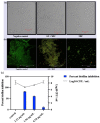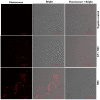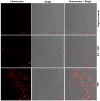Combination Effect of Novel Bimetallic Ag-Ni Nanoparticles with Fluconazole against Candida albicans
- PMID: 35887488
- PMCID: PMC9316949
- DOI: 10.3390/jof8070733
Combination Effect of Novel Bimetallic Ag-Ni Nanoparticles with Fluconazole against Candida albicans
Abstract
The increasing frequency of antifungal drug resistance among pathogenic yeast "Candida" has posed an immense global threat to the public healthcare sector. The most notable species of Candida causing most fungal infections is Candida albicans. Furthermore, recent research has revealed that transition and noble metal combinations can have synergistic antimicrobial effects. Therefore, a one-pot seedless biogenic synthesis of Ag-Ni bimetallic nanoparticles (Ag-Ni NPs) using Salvia officinalis aqueous leaf extract is described. Various techniques, such as UV-vis, FTIR, XRD, SEM, EDX, and TGA, were used to validate the production of Ag-Ni NPs. The antifungal susceptibility of Ag-Ni NPs alone and in combination with fluconazole (FLZ) was tested against FLZ-resistant C. albicans isolate. Furthermore, the impacts of these NPs on membrane integrity, drug efflux pumps, and biofilms formation were evaluated. The MIC (1.56 μg/mL) and MFC (3.12 μg/mL) results indicated potent antifungal activity of Ag-Ni NPs against FLZ-resistant C. albicans. Upon combination, synergistic interaction was observed between Ag-Ni NPs and FLZ against C. albicans 5112 with a fractional inhibitory concentration index (FICI) value of 0.31. In-depth studies revealed that Ag-Ni NPs at higher concentrations (3.12 μg/mL) have anti-biofilm properties and disrupt membrane integrity, as demonstrated by scanning electron microscopy results. In comparison, morphological transition was halted at lower concentrations (0.78 μg/mL). From the results of efflux pump assay using rhodamine 6G (R6G), it was evident that Ag-Ni NPs blocks the efflux pumps in the FLZ-resistant C. albicans 5112. Targeting biofilms and efflux pumps using novel drugs will be an alternate approach for combatting the threat of multi-drug resistant (MDR) stains of C. albicans. Therefore, this study supports the usage of Ag-Ni NPs to avert infections caused by drug resistant strains of C. albicans.
Keywords: Candida albicans; biofilms; efflux pumps; fuconazole resistance; synergistic effect.
Conflict of interest statement
The authors declare no conflict of interest.
Figures








Similar articles
-
Beta vulgaris Assisted Fabrication of Novel Ag-Cu Bimetallic Nanoparticles for Growth Inhibition and Virulence in Candida albicans.Pharmaceutics. 2021 Nov 18;13(11):1957. doi: 10.3390/pharmaceutics13111957. Pharmaceutics. 2021. PMID: 34834372 Free PMC article.
-
Gamma rays-assisted bacterial synthesis of bimetallic silver-selenium nanoparticles: powerful antimicrobial, antibiofilm, antioxidant, and photocatalytic activities.BMC Microbiol. 2023 Aug 16;23(1):224. doi: 10.1186/s12866-023-02971-1. BMC Microbiol. 2023. PMID: 37587432 Free PMC article.
-
Green synthesis of silver nanoparticles using Zingiber officinale and Thymus vulgaris extracts: characterisation, cell cytotoxicity, and its antifungal activity against Candida albicans in comparison to fluconazole.IET Nanobiotechnol. 2019 Apr;13(2):114-119. doi: 10.1049/iet-nbt.2018.5146. IET Nanobiotechnol. 2019. PMID: 31051440 Free PMC article.
-
Fluconazole impacts the extracellular matrix of fluconazole-susceptible and -resistant Candida albicans and Candida glabrata biofilms.J Oral Microbiol. 2018 Jun 4;10(1):1476644. doi: 10.1080/20002297.2018.1476644. eCollection 2018. J Oral Microbiol. 2018. PMID: 29887974 Free PMC article.
-
Candida and candidaemia. Susceptibility and epidemiology.Dan Med J. 2013 Nov;60(11):B4698. Dan Med J. 2013. PMID: 24192246 Review.
Cited by
-
Metal Nanoparticles to Combat Candida albicans Infections: An Update.Microorganisms. 2023 Jan 5;11(1):138. doi: 10.3390/microorganisms11010138. Microorganisms. 2023. PMID: 36677430 Free PMC article. Review.
-
Understanding the Dynamics of Human Defensin Antimicrobial Peptides: Pathogen Resistance and Commensal Induction.Appl Biochem Biotechnol. 2024 Oct;196(10):6993-7024. doi: 10.1007/s12010-024-04893-8. Epub 2024 Mar 13. Appl Biochem Biotechnol. 2024. PMID: 38478321 Review.
-
Facile Synthesis of Magnetic Nigella Sativa Seeds: Advances on Nano-Formulation Approaches for Delivering Antioxidants and Their Antifungal Activity against Candida albicans.Pharmaceutics. 2023 Feb 14;15(2):642. doi: 10.3390/pharmaceutics15020642. Pharmaceutics. 2023. PMID: 36839964 Free PMC article.
-
Characteristics of Metallic Nanoparticles (Especially Silver Nanoparticles) as Anti-Biofilm Agents.Antibiotics (Basel). 2024 Aug 28;13(9):819. doi: 10.3390/antibiotics13090819. Antibiotics (Basel). 2024. PMID: 39334993 Free PMC article. Review.
-
Eco-Friendly Preparation of Silver Nanoparticles and Their Antiproliferative and Apoptosis-Inducing Ability against Lung Cancer.Life (Basel). 2022 Dec 15;12(12):2123. doi: 10.3390/life12122123. Life (Basel). 2022. PMID: 36556488 Free PMC article.
References
-
- Jeyaraj Pandian C., Palanivel R., Dhanasekaran S. Screening antimicrobial activity of nickel nanoparticles synthesized using Ocimum sanctum leaf extract. J. Nanopart. 2016;2016:4694367. doi: 10.1155/2016/4694367. - DOI
-
- Feizi S., Taghipour E., Ghadam P., Mohammadi P. Antifungal, antibacterial, antibiofilm and colorimetric sensing of toxic metals activities of eco friendly, economical synthesized Ag/AgCl nanoparticles using Malva Sylvestris leaf extracts. Microb. Pathog. 2018;125:33–42. doi: 10.1016/j.micpath.2018.08.054. - DOI - PubMed
Grants and funding
LinkOut - more resources
Full Text Sources

